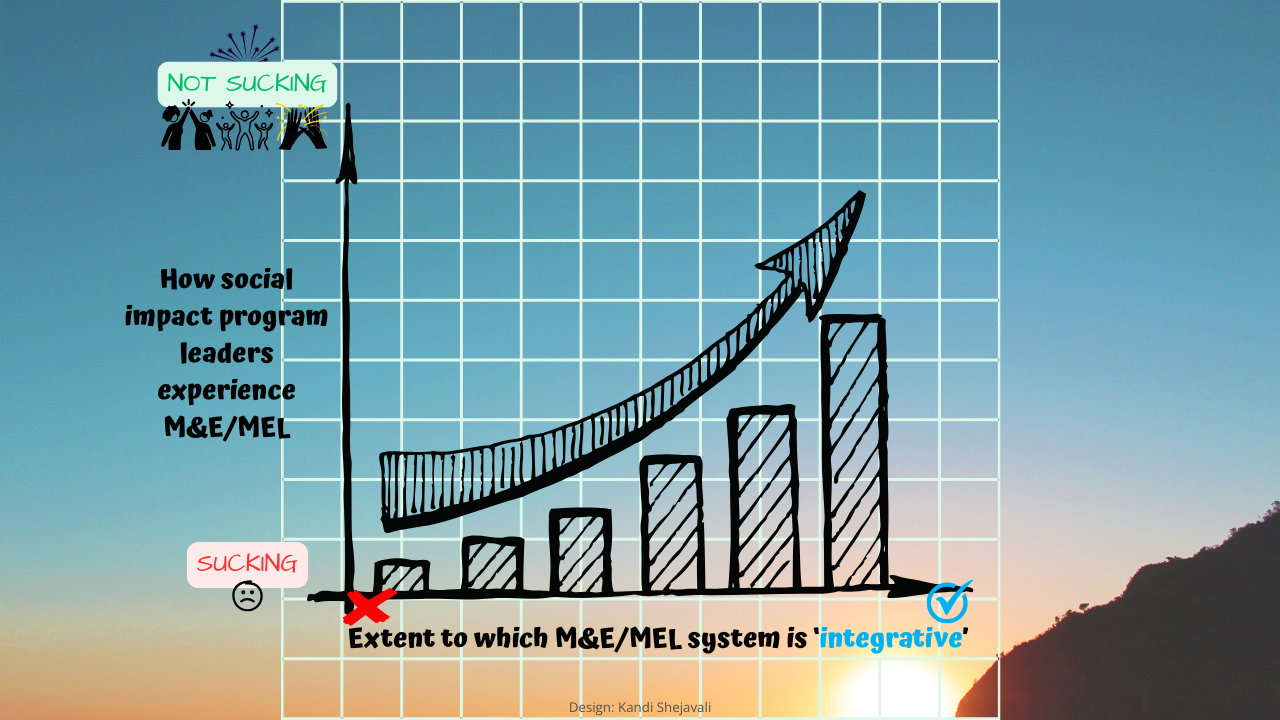M&E responsibilities: why you might want to rethink who they belong to
Feb 14, 2022
“M&E [is] the responsibility of everyone working on a [program]”
What motivated me to say, in a recent interview, that “[monitoring and evaluation (M&E) is] the responsibility of everyone working on a [program]”?
And what might ‘M&E as everyone’s responsibility’ look like?
Let me start answering those two questions in the form of the first act of a classic three-act story.
Act I of a classic three-act story: how M&E responsibilities were traditionally repartitioned and the realization that changed everything
Exposition (um, yes, I’m just going to go ahead and use story-writing terminology for these sub-headings, too!)
Once upon a time, there was a program aimed at delivering positive social impact to 5 rural communities in the northeastern province of a large, biodiversity-rich country in Latin America.
Or was the country in southern Asia?
Or, no, in eastern Africa?
Never mind, there was a program aimed at delivering positive social impact to 5 rural communities in some part of our beautiful world.
That program had a monitoring and evaluation (M&E) system in place, which the M&E Manager had articulated in two documents, the M&E Plan and the M&E Manual.
Everyone on the program team – which consisted of highly motivated sector specialists, technical experts, consultants, finance and admin staff, and of course the M&E Manager – knew of the existence of the M&E documents.
And the team members who did not have “M&E” in their job title had a general idea of how the M&E system worked.
To them, this is how the M&E system worked:
- Whenever anything vaguely M&E-ish came up, they would pass it along to the M&E Manager to handle.
- A query that happened to mention the program’s theory of change (ToC)? Promptly passed along to the M&E Manager.
- Compilation of progress reports? Leave it to the M&E Manager.
- Orienting new community-based program activity managers to the indicators they were to report on? That was for the M&E Manager to handle.
Basically, the M&E Manager – who happened to be named, well, M&E Manager (very apt) – was on the receiving end of all things considered M&E. After all, to the rest of the program team, M&E things were clearly separate from the ‘real work’ they were doing implementing the program.
Inciting incident
But one January afternoon as the program’s director quickly ate lunch at her desk in front of her computer while working – something she always told her team to do so that program results would be produced without interruption –, she came across an article in which an M&E specialist said “M&E [is] the responsibility of everyone working on a [program] because everyone’s efforts affect the [program’s] results.”
She read further, and then she got to thinking about how M&E was done in her program.
Suddenly she understood what the interviewed M&E specialist was saying!
Given that everyone on a program team had a part to play in delivering on the program’s promises, and…
…given that the M&E system measures, tracks, analyzes, assesses, and reports on the delivery of those promises and facilitates the use of the evidence to improve program delivery, …
…everything that all the team members did was and should be M&E-related.
M&E really was everyone’s responsibility!
This realization struck her with such force that she put her fork down (but only for a second!, after all, the lunch was quite delicious…but there were project results to produce, even over the lunch hour).
Plot point 1
The program director – who was named Program Director, by the way – jumped up from her desk, lunch still in hand, and ran through the office ordering everyone away from their desk-bound lunch breaks and into the conference room.
“I have an important announcement to make,” Program Director said, once everyone was gathered.
All eyes were on the Program Director – or, rather, on the Program Director’s delicious-looking lunch, which she continued to eat as she spoke. (The team regretted having forgotten their lunches at their desks, but they hoped that the important announcement was going to be that they were finally going to be allowed to take a break for lunch instead of having to continue working while eating in order not to interrupt the delivery of program results.)
“From this point forward, we’re going to do M&E differently.”
M&E Manager’s ears perked up, sensing that his life at work was about to change dramatically.
“Everyone is going to be more actively responsible for M&E,” Program Director continued. “I finally understand that M&E the task of M&E belongs to all of us as a team. We all have to own it if we want it to achieve what M&E is ultimately about: optimizing programming to more effectively bringing about positive change, telling a credible program story, and maximizing our potential to deliver meaningful program results in the future.”
(The team waited for her to add: “Doing so is going to be much more useful than forcing you to eat lunch at your desks.” But she never did.)
The numerous benefits of repartitioning M&E responsibilities across the project team
What the program director said is exactly it. Program teams need to consider M&E their collective responsibility, with each team member playing an active, rather than passive, role.
Because the curious thing about M&E is that, when viewed holistically, all components of the program are M&E.
As the program director in the story realized:
- since everyone on a program team has a part to play in delivering on results, it makes sense that everyone plays an active role in the system (i.e., the M&E system) that measures, tracks, assesses, and reports on the delivery of those results and that facilitates the use of results information and lessons learned in ongoing program steering.
That is not to say there shouldn’t be an M&E manager who is responsible for the overall coordination of what might classically be categorized as ‘M&E’. That is still necessary, especially for technical M&E tasks such as ensuring that the theory of change (ToC) is robust, verifying the SMART-ness of indicators, or conceptualizing data collection exercises and data visualizations.
But other responsibilities that tend to get thrown into the ‘only-for-the-M&E-manager’ bucket can be explicitly repartitioned.
Here are just a few of the numerous benefits of doing so.
- It gives everyone on the program team an opportunity to participate more actively in the operationalization of the M&E system, thus enabling greater ownership – which is key for assuring the system’s effectiveness.
- It gives everyone on the team an opportunity to understand the M&E system at a deeper level and integrate its principles into their work.
- It improves the M&E system over time as the feedback that the program team provides during reviews of the M&E system (which should be conducted at least annually) will be well informed, enabling the most appropriate and effective refinements to the system.
- It helps everyone be more results-oriented, inviting them to keep at top of mind not just the ‘doing’ of project activities but the more important ‘so what?’ of program activities – i.e., the contextualization of activities in a broader framework that priorities the results that the program is aiming to achieve.
- It makes room for greater creativity, inspiring program team members to always be on the lookout for opportunities to adapt their work to be more responsive to achieving the desired results.
- Ultimately, it maximizes results for the benefit of people and the planet (and it does so much more effectively and pleasantly than forcing project teams to keep working over lunch, like our dear program director in the story did).
Plus, it eases the sometimes-extremely-heavy burden on often-overworked M&E managers.
What ‘M&E as everyone’s responsibility’ might look like
Perhaps by now you’re convinced that M&E tasks should be better repartitioned across the program team.
But how to go about that concretely?
I suggest that the M&E manager maintain technical M&E tasks such as:
- setting the quality standards for the ToC and for indicators;
- ‘holding the pen’ on M&E documents such as the M&E Plan and the M&E Manual;
- conducting data quality assessments (DQAs); and
- taking the lead on drafting the terms of reference for M&E consultants such as survey experts and evaluators.
Tasks like the following can then be repartitioned to other members of the program team:
- explaining the project’s ToC to interested stakeholders;
- initiating the compilation of program progress reports;
- orienting new team members to the objectives of the M&E system and to the indicators that they are to report on;
- conducting programming quality assessments;
- leading regular review sessions to reflect on progress achieved based on the evidence generated from the M&E system and other sources; and
- initiating the adaptation of project activities based on the lessons captured through the M&E system.
And there are many other possibilities.
Conclusion
Appropriately repartitioning M&E responsibilities across the program team has enormous benefits, ultimately helping to maximize the positive results delivered by the program and making our beautiful world a better place to live in for everyone.
So, what are you waiting for?
Over to you!
PRACTICAL TIP #1: Take steps to facilitate the appropriate repartitioning of M&E responsibilities across the program team. This can be done by, for example, ensuring that M&E processes are integrated into ongoing program operations to the greatest extent possible. This is important in and of itself, but the more an M&E system mirrors the program, the more seamless it will be to repartition responsibilities across the whole team.
PRACTICAL TIP #2: Make a list of the various M&E tasks that are carried out for your program and consider how they are repartitioned across the team. To what extent do non-M&E specialist staff participate in the management and operationalization of the M&E system? Does the person with ‘M&E’ in their title bear the entirety of the burden? (Sub-tip: If you’re a program director or other non-M&E specialist, conduct this exercise along with your program’s M&E specialist(s) as they will likely have tasks to add and other input to share that you may not have taken into consideration.)
PRACTICAL TIP #3: If the task list you created in following tip #2 above reveals that non-M&E staff are not assigned any (or enough) M&E responsibilities, engage the team in a discussion about how tasks might be repartitioned so that everyone on the team plays an active role in M&E. In collaboration with the team, create an updated list of more widely and/or evenly distributed task assignments and share it with everyone once it has been finalized and agreed upon.
(And if the task list you created in following tip #2 above shows that non-M&E staff are already assigned M&E responsibilities and are actively engaged in the running of the M&E system to an adequate extent, pat yourself on the back and take a lunch break away from your desk and computer. Don’t worry, I won’t tell our dear Program Director!)
Please share your experience by commenting or leaving an emoticon reaction at the bottom of this LinkedIn post – or, even better, write your own LinkedIn post sharing your reflections on this article! (And if you tag me, Kandi Shejavali, somewhere in the post or in a comment on the post, I’ll be sure to head over and check it out!)





